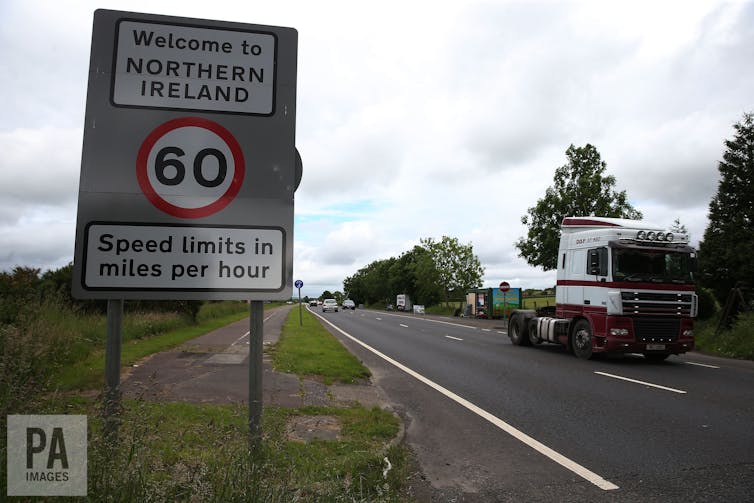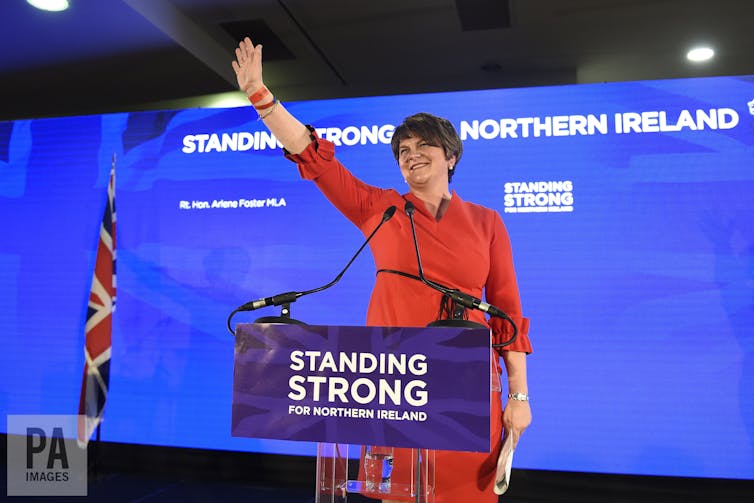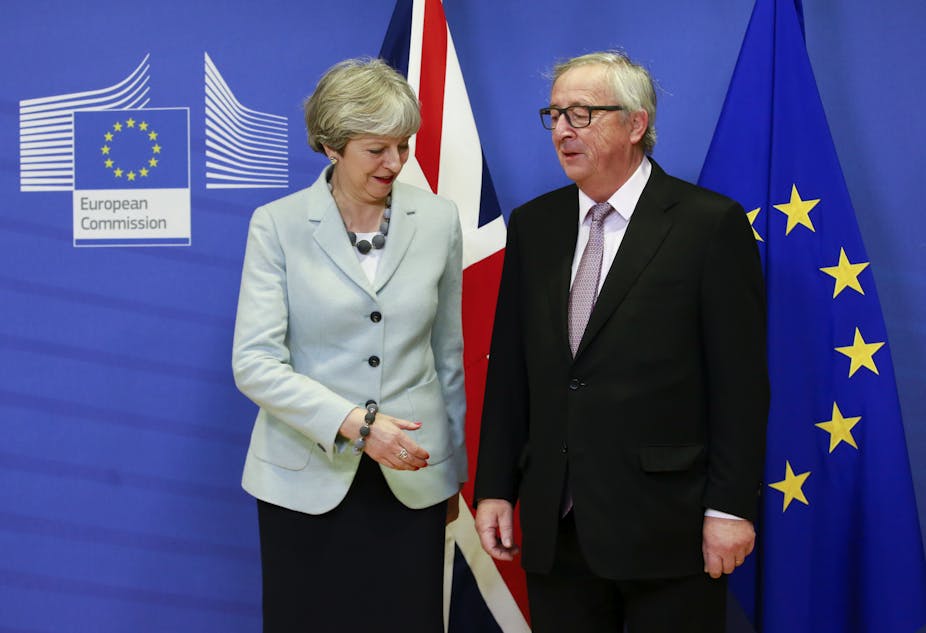EU negotiators announced on December 8 that enough progress has been achieved in Brexit negotiations for talks to move on to a second phase – the nature of the future relationship between the UK and the EU. A deal on the Irish border, a major sticking point in the talks, was given the go-ahead by both the EU and UK. Here academic experts explain aspects of the agreement.
The Irish border
Katy Hayward, Reader in Sociology, Queen’s University Belfast
The UK government still seeks a future deal with the EU that brings the benefits of single market and customs union membership without the obligations. This goal set alarm bells ringing in Brussels and Dublin long ago. Its sheer impossibility meant hurtling towards either a “no deal” scenario (in which case the Irish border would become a hard border) or an “ignore the problem” scenario, in which case the border would be a dangerously gaping hole in the top left corner of the single market.

The joint agreement between the UK and EU secures against both these risks. It asserts that the UK seeks to realise its aims of avoiding a hard border between Ireland and Northern Ireland “through the overall EU-UK relationship”. But it then allows that “should this not be possible”, it will propose “specific solutions” to tie up the loose ends.
In the event that there is a failure to find such agreed solutions, the UK will “maintain full alignment with those rules of the Internal Market and the Customs Union which, now or in the future, support North-South cooperation, the all-island economy and the protection of the 1998 Agreement”.
This is such a major concession, of the tail-wags-dog type, that efforts will be concentrated on finding those “agreed solutions” for Northern Ireland – which we can safely assume will be necessary. The Irish question is far from resolved and there are laborious and detailed negotiations to come.
As such, the joint agreement wisely allows for a special strand of the phase two discussions between the EU and the UK to be dedicated to the “detailed arrangements” necessary to give effect to the ambitious commitments to Northern Ireland/Ireland contained here.
Feargal Cochrane, Professor of International Conflict Analysis, School of Politics and International Relations, University of Kent
So there we have it – more constructive ambiguity, which is fitting in terms of the Good Friday Agreement and broader peace process. This agreement can, and is, being read differently by the Irish government and the DUP, which is hardly surprising.
However, the Irish government position is unequivocal and the deal is essentially much the same as the one rejected by the DUP just days previously, certainly in terms of the implications for trade harmonisation in the two parts of Ireland.
The Irish government is clearly convinced that this means there will, in practice, be no need for border checks between the two jurisdictions after the UK leaves the EU.
The DUP, for its part, is reassured that Northern Ireland will be constitutionally aligned with the rest of the UK after Brexit and there will be no air-lock at Great Britain that differentiates Northern Ireland from the rest of the UK. However, the DUP has, at the same time, admitted that the details of how full alignment will work in practice while maintaining NI’s alignment with the rest of the UK require more detailed explanation.
The implication of the wording is that the UK will have to harmonise with Ireland (which, by the way, means the EU). So it’s not entirely clear how the UK is leaving the customs union and single market, other than saying it has left but in practical terms not actually leaving. This might put the wind up some of prime minister Theresa May’s colleagues, who thought Brexit was going to give them their country back.
It seems like the Irish government has received the guarantee it needed that there will be no visible border in Ireland after Brexit. The UK government and DUP have also bought some time to unscramble how to do this in the next phase of the process.
In essence, while the DUP may choose to dress it up in red, white and blue, it looks like Northern Ireland will be clad in blue and gold for the foreseeable future following this agreement.
Brendan Ciarán Browne, Assistant Professor & Course Coordinator MPhil Conflict Resolution, Trinity College Dublin
Beyond practical realities, symbolically the deal is important. In explicitly dismissing the notion of a hard border on the island of Ireland the negotiating teams have been sensitive to what this could lead to in terms of further political instability in Northern Ireland and the potential for a return to violence.
The hard fought strand in the 1998 Good Friday Agreement focusing on self-determination, that affords citizens born in the north the right to determine as Irish, has undoubtedly been safeguarded as a result of the deal. This allows those in the north who identity as Irish to also remain as European citizens.
By placing the Irish question at the heart of this phase of the negotiations, the EU negotiators realised the symbolic importance of the right to self-determination for citizens in the north. They have also further demonstrated their commitment to upholding the values that are enshrined in the Good Friday Agreement.
David Phinnemore, Professor of European Politics, Queen’s University Belfast
The Irish dimension of Brexit has at last gained the profile it deserves in UK political debate. The assumption that you can leave the EU, its customs union and its single market and avoid any hardening of the Irish border has been exposed as folly.
This is made abundantly clear in the text agreed by the UK and the EU. It commits the UK to regulatory alignment with those EU rules regarding the single market and the customs union that support not just north-south cooperation on the island of the Ireland, but also the “all-island economy” and the protection of the 1998 Good Friday Agreement.
How this is to be achieved has still to be worked out. The same goes for the range of regulations where alignment would be required. Ultimately, if the UK and EU don’t reach agreement on all this when striking a trade deal, the UK has committed to maintaining the “full alignment” necessary. Given the EU’s insistence on respecting the integrity of its own legal order and the UK pledge not to impose a border between Northern Ireland and the rest of the UK, that could in effect mean the whole of the UK staying in the single market and a customs union arrangement with the EU.
The autonomous alignment this entails does not sit well with the “take back control” mantra of many Brexiteers, and that’s before its decided who oversees the eventual arrangement. Whether London can and will deliver remains to be seen.
Gavin Barrett, Professor at the Sutherland School of Law, University College Dublin
With this joint agreement, an unfamiliar concept has found its way into the world’s political lexicon: regulatory alignment. It seem innocuous but don’t be fooled. Regulatory alignment will be the terrain on which Brexit’s ultimate shape will be determined.
The British prime minister, Theresa May, effectively needed Ireland’s assent to move to phase two of Brexit negotiations. Ireland wanted protection against any prospect of renewed controls on the Northern Irish frontier. The result was article 49 of the agreement, promising Ireland that the UK will “maintain full alignment” with the customs union and those internal market rules supporting Ireland’s all-island economy, cooperation and the 1998 Good Friday Agreement. But to please the DUP, article 50 of the agreement nonetheless promises Northern Irish businesses “unfettered access” to the UK single market.

For hardline eurosceptics such as Jacob Rees-Mogg, the ability to diverge from EU regulations in pursuit of international trade deals is an “indelible” red line in Brexit talks. Pleasing them, May still insists the UK will leave both the customs union and the single European market.
These three commitments seem impossible to square – unless the UK does one of three things, each of which anger somebody. First, it angers Eurosceptics by recreating the present EU customs union with another similar EU-UK customs arrangement and by mirroring most single European market rules. Second, it angers the DUP by introducing customs controls on Northern Ireland, while keeping Northern Ireland in the UK’s single market, like a little Norway to the EU’s single market. Or, third, it angers Ireland by giving “full alignment” much less significance than Ireland thinks it has.
It is an impossible trilemma. Something has to give. But that is for another day. For now May’s government, and the truly lunatic escapade that is Brexit, hurtle onwards.
Citizens’ rights
Stijn Smismans, Professor of European Law, Director of the Centre for European Law and Governance, Cardiff University
EU citizens in the UK and British citizens in Europe remain in a lot of uncertainty following the deal on the first stage of Brexit negotiations.
There is some progress in the Joint Agreement on the status and rights people will hold once they have obtained what’s called “settled status”, particularly in relation to family reunion and their acquired social security rights. However, this is far from a guarantee protecting their current rights.
Settled status will not be as protective as the current status of permanent residence. Even people who already hold permanent residence could be deported more easily on grounds of criminality, which goes beyond the restrictive criteria on when EU citizens can be deported that the EU currently allows.
The main problem is that the criteria and checks for registration to get “settled status” remain unclear. Neither is it clear which documents people will need to provide as proof. The previous application system for permanent residence for EU citizens led to nearly 30% of applications being rejected. If similar criteria are applied, such as applicants needing to prove being in work or having sufficient resources to live on, the consequences would be dramatic.
The agreement promises a simplified registration system but does not explain how this will be organised. Neither the criteria for application nor the way in which the online system could reach those most vulnerable are explained.
EU citizens have been promised to have their status guaranteed for life – but the proposal that the EU Court of Justice would lose its control powers over this after eight years undermines that principle.
How Europe reacted
Patricia Hogwood, Reader in European Politics, University of Westminster
The first reactions from Europe to the deal were predictably anodyne. Donald Tusk, president of the European Council, gave all the credit for the breakthrough to Theresa May. While this flatters the prime minister, it also serves the main aim of the European institutions and leading member states – to prop up May’s failing government long enough to conclude a viable Brexit deal.
The Dutch prime minister has declared that he is “happy” that the talks can move on. Only a few have dared to prod the gap between the constructive ambiguity of the statement and the problems that will arise in translating it into an acceptable political compromise in practice. Sven Giegold, a German MEP, has branded the deal a “fake compromise” and claimed that regulatory alignment won’t be enough to avoid a hard border.
What happens now?
Alan Wager, Research Associate, The UK in a Changing Europe at King’s College London
This agreement looks like a political fudge that tells us very little, but keeps the show on the road. In fact, it’s the opposite. We now have a much clearer idea of what Brexit will look like. But, as a result, its political shelf life is limited.
Brexit means “full alignment” – putting the UK firmly in the EU’s sphere of influence when it comes to rules on trade. The Brexit choice at this stage can be boiled down to two different paths: one that continued to hug the EU27 close and remain in their trading sphere of influence, and another that returned “British laws” to the UK and facilitated expansive global trade deals. The first path is looking a lot more likely.
The key issue – how to leave the EU’s frameworks, while not hardening the Irish border – remains unresolved. This is because it is an intractable logical problem that cannot be meaningfully resolved. So the UK will, in any meaningful sense, remain subject to these rules and regulations. The question is, once all this comes out in the wash, whether this softer form of Brexit will still be sellable to Theresa May’s party.
Leading Brexit figures such as Boris Johnson and Michael Gove, sensing in the lead up to this crunch point that the Brexit process could have stalled, have rediscovered the joys of collective cabinet responsibility. But, in the new year, this could come to look less like a fudge, and more like one of those leftover stale mince pies: no one wants it, and harder than it looks.

